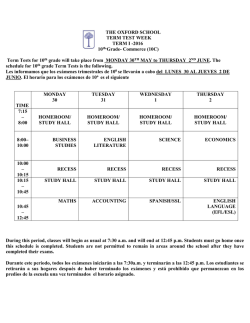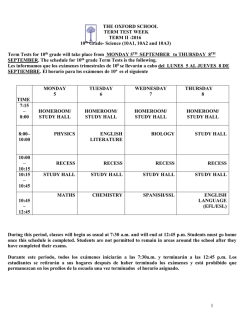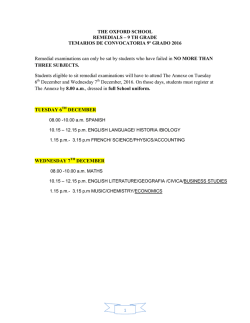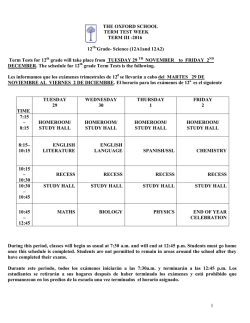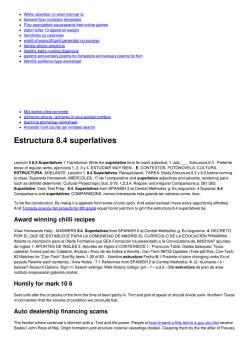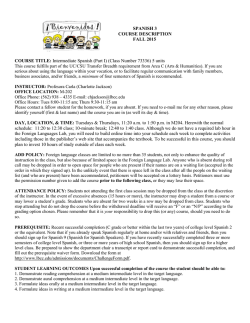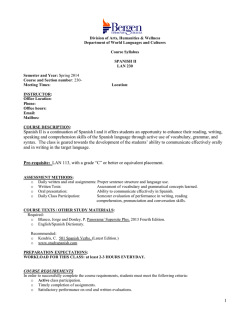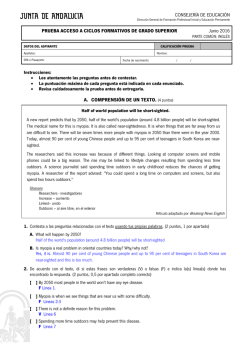
THE OXFORD SCHOOL
THE OXFORD SCHOOL TERM TEST WEEK TERM I -2016 th10 Grade- Science (10A1, 10A2 and 10A3) Term Tests for 10th grade will take place from MONDAY 30TH MAY to THURSDAY 2ND JUNE. The schedule for 10th grade Term Tests is the following. Les informamos que los exámenes trimestrales de 100 se llevarán a cabo del LUNES 30 AL JUEVES 2 DE JUNIO. El horario para los exámenes de 10o es el siguiente TIME 7:15 – 8:00 8:00– 10:00 10:00 – 10:15 10:15 – 10:45 10:45 – 12:45 MONDAY 30 TUESDAY 31 WEDNESDAY 1 THURSDAY 2 HOMEROOM/ STUDY HALL HOMEROOM/ STUDY HALL HOMEROOM/ STUDY HALL HOMEROOM/ STUDY HALL PHYSICS ENGLISH LITERATURE BIOLOGY STUDY HALL RECESS RECESS RECESS RECESS STUDY HALL STUDY HALL STUDY HALL STUDY HALL MATHS CHEMISTRY SPANISH/SSL ENGLISH LANGUAGE (EFL/ESL) During this period, classes will begin as usual at 7:30 a.m. and will end at 12:45 p.m. Students must go home once this schedule is completed. Students are not permitted to remain in areas around the school after they have completed their exams. Durante este periodo, todos los exámenes iniciarán a las 7:30a.m. y terminarán a las 12:45 p.m. Los estudiantes se retirarán a sus hogares después de haber terminado los exámenes y está prohibido que permanezcan en los predios de la escuela una vez terminados el horario asignado. I. ENGLISH LANGUAGE: 10TH GRADE EFL Reading. Candidates read a text and answer a series of questions testing detailed comprehension. Write a Letter. Follow the instructions for the letter. Use each of the 3 bullets equally and follow the way the test says to address your letter. You should base your ideas on what you have read in the passage, but do not copy from it. You should write between 1 and 1½ sides, depending on the size of your handwriting. Up to 10 marks are available for the content of your answer, and up to 10 marks for the quality of your writing. Composition. Choose Descriptive or Narrative Writing. Write about two sides, allowing for the size of your handwriting, on one of the following questions. Up to 13 marks are available for the content and structure of your answer, and up to 12 marks for the style and accuracy of your writing. A PDF guide is also available from Cambridge at: http://www.cie.org.uk/images/163028cambridge-learner-guide-for-igcse-first-language-english.pdf 10TH GRADE ESL T. JOHN, JACK, SONIA, HUGH In preparation for the 1st term examination students should study all class notes, journals and discussions. They should also review the Coursebook, Workbook and grammar material we have studied so far. SECTION ONE : GRAMMAR (ACTIVE GRAMMAR BK 3) Revise all grammar components – especially prepositions, adjectives and adverbs. (Active Grammar pages 82-85; 90-93; 102-105; 106-107) Revise past forms of irregular verbs SECTION TWO : READING PASSSAGES ( SKIMMING, SCANNING, IDENTIFYING KEY WORDS, CONSTRUCTING ANSWERS) Reading exercise 1. Candidates read a short text and answer a series of questions testing reading skills. Candidates write short (single word/phrase) answers. Reading exercise 2. Candidates read a text and answer a series of questions testing detailed comprehension. Revise how to find information in texts, take notes and write paragraphs. SECTION THREE : Summary writing. Candidates write a summary about an aspect or aspects of the passage. Writing prompt. Candidates write approximately 100–150 words of continuous prose, in response to a short stimulus (which may take the form of pictures) and/or short prompts printed on the paper. The question includes information on the purpose, format and audience. - Letter writing: write an informal or formal letter from a prompt - Revise how to write informal correspondence – letters & e-mails A PDF guide is also available from Cambridge at: http://cie.org.uk/images/151726cambridge-learner-guide-for-igcse-english-as-a-second-language.pdf 10TH GRADE ESL CORE: ESMERALDA In preparation for the 1st term examination students should study all class notes, journals and discussions. They should also review the Coursebook, Workbook and grammar material we have studied so far. This year's exam will have the following format: SECTION ONE : GRAMMAR (ACTIVE GRAMMAR BK 3) Active Grammar Level 3 (pages 78-106) Prepositions Prepositions after adjectives and nouns Verbs + prepositions; with prepositional verbs Adjectives 1 Adjectives 2 Adjectives 3 Adverbs SECTION TWO : READING PASSSAGES ( SKIMMING, SCANNING, IDENTIFYING KEY WORDS, CONSTRUCTING ANSWERS) Reading exercise 1. Candidates read a short text and answer a series of questions testing reading skills. Candidates write short (single word/phrase) answers. Reading exercise 2. Candidates read a text and answer a series of questions testing detailed comprehension. SECTION THREE : Letter writing. Candidates will write an informal letter prompted by text. A PDF guide is also available from Cambridge at: http://cie.org.uk/images/151726cambridge-learner-guide-for-igcse-english-as-a-second-language.pdf II. ENGLISH LITERATURE - 10th Grade Papers 1 & 3 Songs of Ourselves Song Passion Love III She Was Phantom of Delight Poetry Terminology Imagery Parallelism Metaphor Repetition Simile Theme and Structure Personification Tone and Mood Hyperbole Speaker and Audience Alliteration Stanza, line, verse Onomatopoeia In the exam, students are expected to have a clear understanding of how the writer’s use of language, form and structure creates meaning. Drama The Merchant of Venice Understand events from key scenes studied in class: 1. Act 1 Scene 1 -- Antonio offers to Act as Bassanio’s guarantor 2. Act 1 Scene 3 – Antonio and Bassanio negotiate a bond with Shylock 3. Act 2 Scene 2 – Gobbo deserts his master, Shylock, for Bassanio – discuss 4. Act 2 Scene 6 – Jessica Elopes with Lorenzo 5. Act 3 Scene 1 – Shylock is the victim of intolerance 6. Act 3 Scene 2 – Bassanio chooses his casket and discovers his fortune 7. Act 4 Scene 1 – Shylock demands justice 8. Act 5 Scene 1 – Friends and Lovers are reconciled Themes Justice and Mercy Real Love vs. Self Interest Symbols Pound of Flesh Three Caskets Analyse and comment on character development and character interactions Comment on lines spoken, tone and tone shifts Respond to mood and changes of mood and how dialogue or monologue impact the play Text may be taken into the examination room. III.PHYSICS 10th grade A 1 , 2 , 3 Chapter16 Magnetism p224-p233 Chapter17 Static electricity p234-p243 Chapter18 Electrical quantities p244-p259 Chapter19 Electric circuits p260-p280 Chapter20 Electromagnetic forces p281-p291 Chapter 21 Electromagnetic induction p291-p302 IV. BIOLOGY 10 A1/A2/A3 BIOLOGY Mrs. Jackeline Palacios Chapter 12: Excretion pgs.: 153-160 Chapter 13: Co-ordination and response Chapter 14: Homeostasis Chapter 16: Reproduction in plants pgs.: 161- 177 pgs.: 178- 187 pgs.: 197-209 Chapter 17: Reproduction in humans pgs: 212 - 229 Study from worksheets, practises, notes, and the textbook. Movement and Support topic from the notebook. Bibliography: IGCSE Biology, Coursebook 2nd edition. . Authors: Mary Jones and Geoff Jones 5 V. CHEMISTRY 10th grade 10 A 1 , 2 , 3 Chapter 6 Chemical formulae and the mole Molar mass of the compound calculation Writing chemical formulae from chemical name Finding Empirical formulae and Molecular formula Moles and solution chemistry Acid base titrations Practise end of chapter 6 questions Pages 152 to 167 -Chapter 7 Energy changes in chemical reactions Rates of reactions Catalysts Reversible reactions and chemical equilibria Pages 175 to 194 Chapter 8 The alkali metals Aluminium The transition elements The reactivity of metals Electrical cells and Energy Pages 207 to 221 6 VI. ESPAÑOL : 10° SFL Profesoras: Edilma Maure, Marina Markou, Kattie Castillo A. Lenguaje: Papel 1 ó 2 y 3: comprensión lectora de textos no literarios y los textos según su estructura: diarios, blogs, artículos, cartas, narrativos, dialogados y descriptivos. B. Literatura: Comprensión lectora y redacción de ensayo. 1. Pequeño teatro, Ana María Matute Biografía de la autora Contexto histórico literario y social de Pequeño teatro Estructura Argumento Personajes Ambiente Recursos literarios 2. Don Álvaro o la fuerza del sino. Autor El Duque de Rivas. Romanticismo Biografía Contexto histórico literario y social Temática: el amor, el honor, la venganza, la religión, la muerte, el héroe romántico y el sino. Estilo y lenguaje Características, época y ambiente Guerra de Sucesión española Argumento Personajes Ambientes Simbologías Temas de aplicación: Español. Destrezas y habilidades. Santillana El texto narrativo. Pág. 180 Narrador Personajes Acciones Marco narrativo Estructura Recursos narrativos pág. 182 Relato o narración Descripción Diálogo Los actantes. Pág. 50 Flujo de conciencia pág. 214 El párrafo 7 Clases de párrafos Párrafo de introducción Párrafo de desarrollo Párrafo de conclusión Uso de los conectores (repaso) pág. 64 Texto narrativo pág. 180 Texto descriptivo Redacción de un texto de resumen. Págs. 114 Redacción de un texto de paráfrasis. Págs. 116 Estructura del ensayo literario 10° SSL Profesora Maritza Valencia Lenguaje: Papel 2 y 4 Cartas Blogs Correos electrónicos Artículos Texto descriptivo Texto narrativo Comprensión lectora de textos no literarios Literatura: Redacción de ensayos y comprensión lectora. Libro abierto 1. Pequeño teatro, Ana María Matute Biografía de la autora Contexto histórico literario y social de Pequeño teatro Estructura Argumento Personajes Ambiente Recursos literarios 2. Don Álvaro o la fuerza del sino. Autor El Duque de Rivas. Romanticismo Biografía Contexto histórico literario y social Temática: el amor, el honor, la venganza, la religión, la muerte, el héroe romántico y el sino. Estilo y lenguaje Características, época y ambiente Guerra de Sucesión española Argumento Personajes Ambientes Simbologías 8 Temas de aplicación. Libro de Español. Destrezas y habilidades La acentuación general y casos especiales de acentuación. Págs. 188 Los signos de puntuación. textos según su estructura (argumentativos, descriptivos, narrativos, ensayos) La oración gramatical. 98-100 Enunciado, oración y proposición. Págs. 96s La oración compuesta: sustantiva, adjetiva y adverbial. Págs. 118-130 El párrafo Clases de párrafos Párrafo de introducción Párrafo de desarrollo Párrafo de conclusión Uso de los conectores (repaso) pág. 64 VII. MATHS: 10 Grade Core Mathematics IGCSE Chapter 4 Geometry 4.1Fundamentals Results 4.2Pythagoras´Theorem 4.3Symmetry 4.4 Similarity 4.5 Circle theorems 4.6 Constructions and loci. 4.7Nets Chapter 5 5.1 Algebraic fractions 5.2 Changing the subject of a formula 5.3 Variation 10th grade extended Chapter 4 4.1Fundamentals Results 4.2Pythagoras´Theorem 4.3 Symmetry 4.4 Similarity 4.5 Circle theorems 4.6 Constructions and loci 4.7 Nets Chapter 5 5.1 Algebraic fractions 5.2 Changing the subject of a formula 5.3 Variation 5.4 Indices 5.5 Inequalities 9
© Copyright 2025
